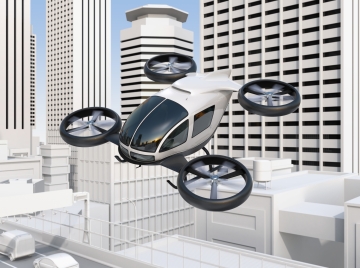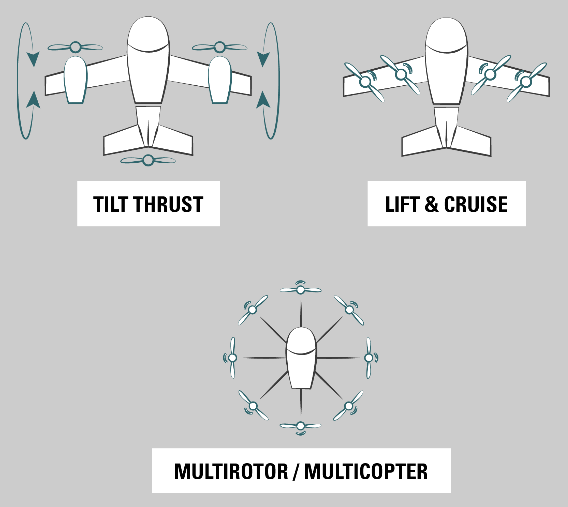Urban air mobility: the insights of your future transportation

Urban air mobility must be one of the most exiting transportation evolutions to come. Read all about the future possibilities of getting around by air.
Urban air mobility must be one of the most exiting transportation evolutions to come. Read all about the future possibilities of getting around by air.
First of all, we shall start with a clear description of what is meant by urban air mobility (UAM). Nasa defines UAM as a safe and efficient system for air passenger and cargo transportation within an urban area, inclusive of small package delivery and other urban unmanned aerial systems (UAS) services, which supports a mix of onboard piloted, ground-piloted, and increasingly autonomous operations.
Most of UAM's concepts and prototypes are eVTOLs or electric-powered vertical take-off and landing aircrafts; which can hover, take off, and land vertically. Within the eVTOLs range, there are three distinctions. Firstly, the Tilt-Thrust, which tilts his wings or rotors depending on the direction of flight, take-off or cruise. Secondly, Lift and Cruise, which uses a distinct propulsion for takeoff and for cruising. Finally, Multirotor, which is a vehicle without wings with several fixed rotors that tilts its air frame for lift or cruise. When listing these features you quickly make the comparison with a helicopter, but these eVTOLs have some substantial advantages. EVTOLs are generally quieter, more reliable, safer and noticeably cheaper.

Source: https://uam.fev.com/
The urban air mobility possibilities will presumably be dominated by tree different kinds of passenger transportation purposes:
1. city taxis,
2. airport shuttles,
3. intercity jets
The manufacturers predict that both the city taxis and the airport shuttles will have a range of 15 to 50 kilometers, while the intercity jets will be able to cover distances until 250 kilometers. To be clear, flights with the flying vehicles will only be possible between two landing stations, especially in the early days. On-demand air taxi service with a network of landing nodes, similar to funicular stations, where passengers embark or disembark could be offered. They are capable of operating independently of the road network, and thus of traffic congestion, allowing accurate calculation of arrival times. Making its use particularly promising for airport shuttles.
This thrilling new way of transportation becomes more real in the following of this year. The prototype of a German company will be tested from June 2021 on, at an airport near Paris. “The Volocopter”, as the prototype is named, is a driverless aircraft designed to transport people trough cities and urban environments. It runs on 9 electric batteries and is able to carry a passenger and if necessary a pilot. Presumably the flying vehicle has a range of 35 kilometers and is capable of reaching a speed of 110 kmh. If trials of the next year are conclusive, Paris authorities aim to have a prototype ready for demonstrational flights at the 2024 Paris Olympics.
While you are reading this, you may picture yourself a day when flying vehicles are a reality and that this might happen faster than you ever imagined. However, before this can be realized there are quite a few things that still need to be considered. In fact, the idea of having flying vehicles as the future of transportation has some infrastructure related implications. First, air traffic regulations must be developed, having a vast amount of flying vehicles could easily lead to a disaster if not managed properly. For airplanes, this is presently under strict control and active monitoring is required. Secondly, charging stations, insurance policies and parking guidelines would also require to be properly addressed. At least at present, neither of these issues has been properly addressed. Obviously, this would play a major role in achieving that transportation future. Therefore, it is a valid reason to start with city cabs, airport shuttles and intercity jets regulated by the government or a central entity before flying vehicles can be purchased for personal use as well.
Sources
Euronews. (2020, October 2). Could new electric ‘air taxi’ be the future of travel? https://www.euronews.com/2020/...
Kainaris, N. (2020, April 8). Air taxis – the future of urban mobility? PTV Blog. https://blog.ptvgroup.com/en/c...
Urban Air Mobility (UAM) by FEV. (n.d.). FEV and Urban Air Mobility (UAM). https://uam.fev.com/
Writer, S. (2020, September 11). The Future of Transportation Is Now – Flying Cars Could Be a Reality. Bold Business. https://www.boldbusiness.com/h...
Well, it shouldn't be long until air taxis become an obvious part of the European cityscape. Currently, around 110 cities and regions worldwide are developing solutions in this regard, and the number of emerging new players on the market is increasing. Startups and long-established aviation enterprises are in the process of developing air cabs and services for various sectors. In the European Union, traffic congestion alone is costing roughly €100 billion each year. By 2030 this amount is predicted to increase until €300 billion. An appropriate solution to this tremendous problem could be found in the third dimension, the sky, in the form of urban air mobility.
Latest insights & stories

A Global Movement: The World Unites in a Pink Pledge for Clean and Sustainable Water
5,000 participants. 32 countries. €30,000 funds raised. And that's just the beginning.
Picture this: One step that sends ripples across the globe, transforming lives and creating waves of change. You might wonder, how can such a simple action for most of us have such a profound impact?

Sustainability and circularity in construction
Join us in transforming the future of construction, creating buildings that not only stand the test of time but also contribute to a healthier planet!

RainTunes: Shower scenarios for the soul
Light, hearing, smell, and touch: Together with experts, we have developed sensuous scenarios that turn showering into an individual experience. Whether you want to prepare for the day ahead or relax after working out. Whether you want to refresh after a day’s work or unwind at the end of the evening: RainTunes surprises with multisensory experiences.*
*Currently available only in Germany and Austria.